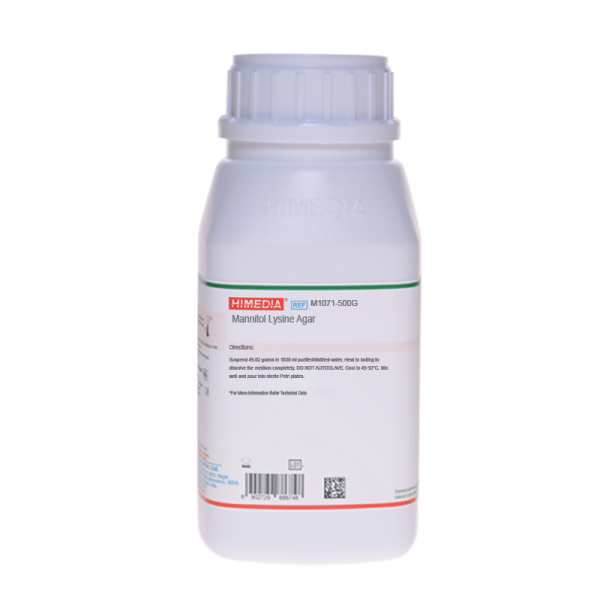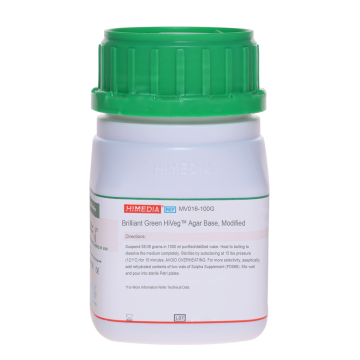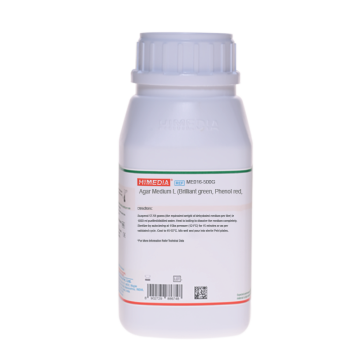 Your enquiry has been submitted
Your enquiry has been submitted
Mannitol Lysine Agar
Intended Use:
For selective isolation of Salmonellae other than Salmonella Typhi and Salmonella Paratyphi A.
Composition**
| Ingredients | g/L |
|---|---|
| Peptone | 10.000 |
| Yeast extract | 5.000 |
| HM peptone B # | 2.000 |
| Sodium chloride | 4.000 |
| Mannitol | 3.000 |
| L-Lysine hydrochloride | 5.000 |
| Sodium thiosulphate | 4.000 |
| Ferric ammonium citrate | 1.000 |
| Brilliant green | 0.0125 |
| Crystal violet | 0.010 |
| Agar | 15.000 |
Final pH (at 25°C): 6.8±0.2
**Formula adjusted, standardized to suit performance parameters
# Equivalent to Beef extract
Directions
Suspend 49.02 grams in 1000 ml purified / distilled water. Heat to boiling to dissolve the medium completely. DO NOT AUTOCLAVE. Cool to 45-50°C. Mix well and pour into sterile Petri plates. Cool to 45-50°C.
Principle And Interpretation
Human Salmonella infections are most commonly caused by ingestion of food, water or milk contaminated by human or animal excreta (1). One of the most important criteria in the identification of Salmonella species is the production of hydrogen sulphide. Salmonella Typhi and Salmonella Paratyphi A can be differentiated from the rest of the Salmonella due to their inability to form hydrogen sulphide.
Mannitol Lysine Agar, formulated as described by Inoue et al (2) is used for the selective isolation of Salmonella species other than Salmonella Typhi and Salmonella Paratyphi A from different foods and faeces. Mannitol Lysine Agar may be used directly with the specimen or from an enrichment culture (3). Enrichment can be carried out in Modified Semisolid RV Medium (M1482). Mannitol Lysine Agar does not depend upon lactose fermentation and is therefore recommended for investigating lactose fermenting Salmonellae like Salmonella Arizonae. Further tests should be carried out for confirming Salmonella species.
Peptone, HM peptone B, yeast extract provide essential nutrients for the growth of Salmonella. Mannitol is the fermentable carbohydrate in the medium while L-lysine is the amino acid. Salmonellae grow as large purple colony with black center because of H2S production. Mannitol is fermented by organisms and the resulting acid stimulates lysine decarboxylation. This elevates the pH due to production of amines and promotes blackening. Sodium thiosulphate and ferric ammonium citrate help in H2S production. Atypical Salmonella strains do not produce H2S and form grey colonies. Brilliant green dye in the medium inhibits gram-positive and majority of gram-negative organisms.
Mannitol Lysine Medium should be used in conjunction with Brilliant Green Agar, Modified (M016) or Bismuth Sulphite Agar (M027). Mannitol Lysine Medium can be directly inoculated with the specimen or the specimen can be first enriched in Modified Semisolid RV Medium Base (M1482). Atypical Salmonella will form a characteristic bulls eye due to less H2S production, which gets concentrated in the centre of the colony. Salmonella colonies will form purple black colonies. Presumptive Salmonella should be confirmed by biochemical tests.
Type of specimen
Clinical samples - Faeces
Specimen Collection and Handling:
For clinical samples follow appropriate techniques for handling specimens as per established guidelines (4,5).
After use, contaminated materials must be sterilized by autoclaving before discarding.
Warning and Precautions :
In Vitro diagnostic Use only. For professional use only. Read the label before opening the container. Wear protective gloves/protective clothing/eye protection/ face protection. Follow good microbiological lab practices while handling specimens and culture. Standard precautions as per established guidelines should be followed while handling clinical specimens. Safety guidelines may be referred in individual safety data sheets.
Limitations :
- Individual organisms differ in their growth requirement and may show variable growth patterns on the medium.
- Each lot of the medium has been tested for the organisms specified on the COA. It is recommended to users to validate the medium for any specific microorganism other than mentioned in the COA based on the user's unique requirement.
- Presumptive Salmonella should be confirmed by biochemical tests.
Performance and Evaluation
Performance of the medium is expected when used as per the direction on the label within the expiry period when stored at recommended temperature.
Quality Control
Appearance
Light yellow to greenish yellow homogeneous free flowing powder
Gelling
Firm, comparable with 1.5% Agar gel
Colour and Clarity of prepared medium
Light purple to purple with green tinge clear to slightly opalescent gel forms in Petri plates.
Reaction
Reaction of 4.9% w/v aqueous solution at 25°C. pH : 6.8±0.2
pH
6.60-7.00
Cultural Response
Cultural characteristics observed after an incubation at 35-37°C for 18-48 hours.
| Organism | Inoculum (CFU) | Growth | Recovery | Colour of colony |
|---|---|---|---|---|
| Escherichia coli ATCC 25922 (00013*) | >=104 | inhibited | 0% | |
| Salmonella Paratyphi B ATCC 8759 | 50-100 | luxuriant | >=50% | purple with black centre |
| Salmonella Typhi ATCC 6539 | 50-100 | None-poor | 0-10% | colourless with purple tinge, may have black centres |
| Salmonella Typhimurium ATCC 14028 (00031*) | 50-100 | luxuriant | >=50% | purple with black centre |
| Salmonella Enteritidis ATCC 13076 (00030*) | 50-100 | luxuriant | >=50% | purple with black centre |
| Staphylococcus aureus subsp. aureus ATCC 25923 (00034*) | >=104 | inhibited | 0% |
Key: *Corresponding WDCM numbers.
Storage and Shelf Life
Store between 10-30°C in a tightly closed container and the prepared medium at 2-8°C. Use before expiry date on the label. On opening, product should be properly stored dry, after tightly capping the bottle in order to prevent lump formation due to the hygroscopic nature of the product. Improper storage of the product may lead to lump formation. Store in dry ventilated area protected from extremes of temperature and sources of ignition. Seal the container tightly after use. Product performance is best if used within stated expiry period.
Disposal
User must ensure safe disposal by autoclaving and/or incineration of used or unusable preparations of this product. Follow established laboratory procedures in disposing of infectious materials and material that comes into contact with clinical sample must be decontaminated and disposed of in accordance with current laboratory techniques (4,5).
Reference
- Koneman E. W., Allen S. D., Janda W. M., Schreckenberger P. C., Winn W. C. Jr., 1992, Colour Atlas and Textbook of Diagnostic Microbiology, 4th Ed., J. B. Lippinccott Company
- Takao Inoue et al, 1968, Jap. J. Vet. Sci., 30.
- Aspinall S. T., Hindle M. A. and Hutchinson D. N., 1992, Eur. J. Clin. Microbiol. Inf. Dis., 11:936.
- Isenberg, H.D. Clinical Microbiology Procedures Handbook 2nd Edition.
- Jorgensen, J.H., Pfaller, M.A., Carroll, K.C., Funke, G., Landry, M.L., Richter, S.S and Warnock., D.W. (2015) Manual of Clinical Microbiology, 11th Edition. Vol. 1.
| Product Name | Mannitol Lysine Agar |
|---|---|
| SKU | M1071 |
| Product Type | Regular |
| Physical Form | Powder |
| Origin | Animal |
| Packaging type | HDPE |
| References | 1. Koneman E. W., Allen S. D., Janda W. M., Schreckenberger P. C., Winn W. C. Jr., 1992, Colour Atlas and Textbook ofDiagnostic Microbiology, 4th Ed., J. B. Lippinccott Company |
| Customized Product Available | No |









